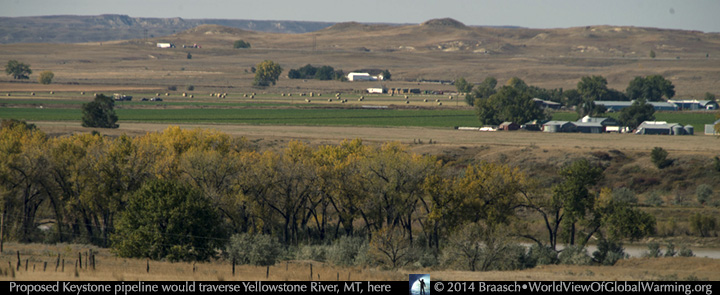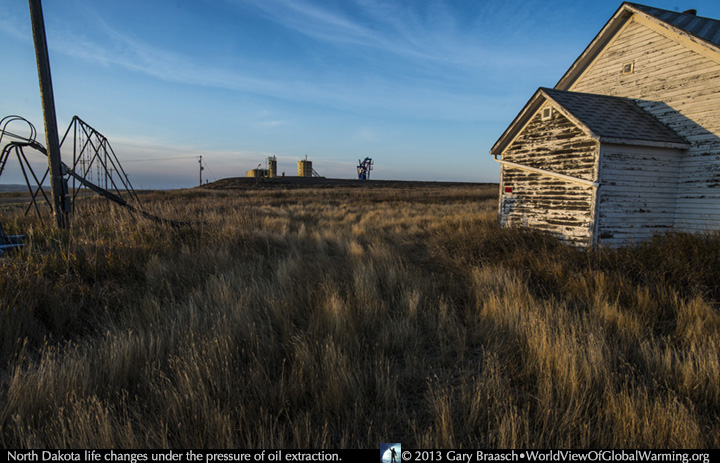Climate Photo of the Week
Keystone pipeline report downplays climate pollution from pumping and burning oil sands crude; project moves toward decision by President
The Keystone XL oil pipeline, proposed to carry greenhouse gas-intensive oil sands crude from Canada to U.S refineries, would increase global warming emissions, but not by a significant amount compared to burning other kinds of crude oil, according to an Environmental Impact Statement released by the U.S. State Department on January 31. In the long awaited report the State Department rejected the idea that not building the pipeline would stifle oil extraction from the Alberta tar sands, a major goal of environmental and climate action groups . "Such a change is not likely to occur," the report said, because demand for oil will continue, and crude oil will reach refineries by other means from the tar sands, and from other sources. The report said that although thousands of workers would be employed during construction, only 35 permanent employees would remain for operations.
The environmental analysis is central to a decision by President Obama whether to allow construction of the pipeline. which will carry 830,000 barrels of oil daily under 875 miles of Montana, South Dakota and Nebraska, under or through 62 rivers and water bodies. Please see www.braaschphotography for more on environmental impacts. Because it crosses the U.S. Canada border into Montana, the pipeline is being studied by the State Department to determine if it is in the national interest. The report issued January 31 said that the oil sands petroleum creates "an estimated 17 percent more GHGs on a lifecycle basis than the average barrel of crude oil refined in the United States," but that American and international markets would continue a demand for the Canadian crude even without the Keystone pipeline. Environmental and climate action leaders pointed out that the EIS looks at the oil use in isolation, assuming it has to be used, giving almost no consideration of energy actions to cut back on fossil fuels. For other issues revealed in the report, including threats to water from oil leaks, see this NRDC blog. The President declared in June "our national interest will be served only if this project does not significantly exacerbate the problem of carbon pollution." And in his recent State of the Union address, he said that a cleaner energy economy "will require some tough choices along the way. But the debate is settled. Climate change is a fact. And when our children's children look us in the eye and ask if we did all we could to leave them a safer, more stable world, with new sources of energy, I want us to be able to say yes, we did."
More information on www.BraaschPhotography.com
Fossil fuels roll on in 100-car trains from North Dakota; regulators and citizen groups focus on safety and emissions.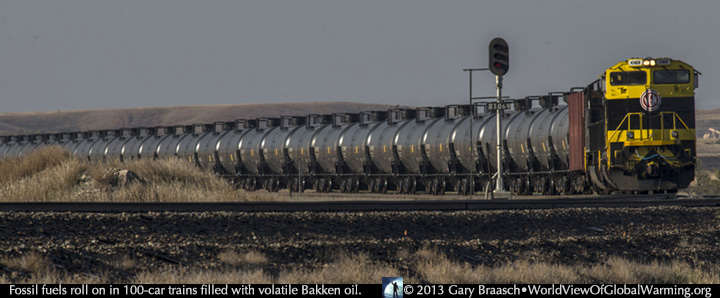
It's a huge transformation of the northern plains and of American energy sources -- the Bakken oil field of North Dakota and Montana now rivals Texas in oil production. The area of the Bakken near Williston ND now has more than 6,600 wells in a fracking-driven rush that began less than 5 years ago. The state is adding up to 200 new wells each month. World View of Global Warming photographed and reported in the area in late fall, producing a photo story for The Daily Climate.
The Bakken's development has transformed the domestic energy debate. The field, the largest oil formation in the United States, is producing nearly a million barrels a day – more than double the rate just two years ago. One result is that Congress is considering lifting a ban on oil exports in place since the OPEC oil embargo of the 1970s.
But with the rush came community problems in the region: Runaway population growth, severe housing and school shortages, crime and other disruptions are now common in what had been mostly empty agricultural country,. The social, labor and financial challenges have been substantial.
Also a challenge: Getting the product to refiners. The main route out of the Bakken is via 100-car oil trains, but concerns about the safety of rail transport abound, ignited by July's fatal tank car disaster in Lac-Megantic, Quebec and a December crash in North Dakota that forced almost 2400 people from their homes. Bakken oil, more volatile than the heavier crude from other regions, is mostly carried in older tank cars which are not as resistant to rupturing as more modern cars. Also, with the Bakken's growth have come increased protests over fossil fuel rail traffic across the West and concerns over the oil boom's negative effect on reduction of greenhouse gases.
More soon on The Daily Climate and other websites.


In a special issue, Destruction, art, and the Doomsday Clock, the Bulletin of the Atomic scientists explores how we are influenced for good or ill by the images we see of nuclear proliferation and rapid climate change. Gary Braasch was commissioned to investigate the history and usefulness of the tens of thousands of photographs, charts, graphs, cartoons, illustrations, and moving images that we have seen about global warming. The content of climate imagery falls into several broad categories, Gary writes, and not all of them have been effective in educating people about the dangers and causes of climate change or encouraging civic action and involvement. Documented research and experience shows that a new framing of local climate impacts and positive actions may encourage more people to take action.
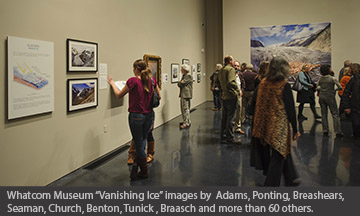
Gary Braasch is honored to be among the artists featured in the exhibition Vanishing Ice: Alpine and Polar Landscapes in Art 1775-2012, at the Whatcom Museum, Bellingham WA. The large show offers a glimpse into the rich cultural legacy of the planet’s frozen frontiers. International in scope, it traces the impact of glaciers, icebergs and fields of ice on artists’ imaginations. Curator Barbara Matilsky chose Gary's set of then and now images of the Athabasca Glacier in Canada for display, along with a science-based caption and copy of gary's book Earth Under Fire.
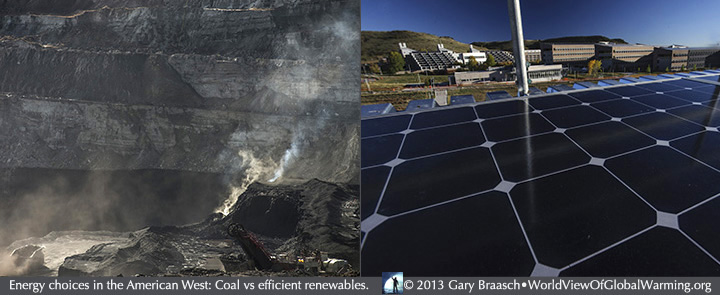
The U.S. government energy policy of "All of the Above" plays out grandly across the Western landscape. It spans from the upper great plains of Montana and North Dakota, where crude oil production was over 900,000 barrels a day in August, and in Wyoming where coal mining provided most of the US supply -- across to Oregon and Washington's Columbia River where hydropower has been created since the 1930s but wind is a major energy source now. World View of Global Warming's detailed photo story about the Powder River Basin coal region is the first in a new series on The Daily Climate about western energy today. Thanks to Scientific American and Grist for re-posting this story for their readers.
And look for more on energy and how to be an active, concerned citizen on our Action Pages.
Other recent stories available on World View of Global Warming
A lone scientist reveals the meaning of a melting Arctic Ocean: “You don’t have to care about Arctic seabirds or pack ice,” George Divoky told World View of Global Warming, because the Arctic is not the only place where climate change is causing problems. “Species are struggling to deal with it,” he says, “and we are going to be in the same situation.” Please see story and portfolio here.
In the Pacific Northwest, the oyster industry, with an $84 million yearly value and 3,000 employees, is already seeing and reacting to the effects of unhealthy ocean water.
Story and photos here.
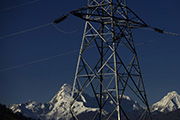 The fabled Himalayan kingdom of Bhutan stands alone among nations for its strong Buddhist faith, Constitutional concern for the happiness of its people, a monarchy that gave up power to establish democracy, its preservation of ecosystem,s and as the only nation to sequester much more carbon than it emits. In recent years, Bhutan, like other Himalayan areas, has seen an increase in landslides due to heavier rains, and some glacial lake outburst floods (GLOFs) as glaciers retreat. Our report from a visit to this unique nation, which faces difficult choices among ecosystems and energy needs, may be seen here.
The fabled Himalayan kingdom of Bhutan stands alone among nations for its strong Buddhist faith, Constitutional concern for the happiness of its people, a monarchy that gave up power to establish democracy, its preservation of ecosystem,s and as the only nation to sequester much more carbon than it emits. In recent years, Bhutan, like other Himalayan areas, has seen an increase in landslides due to heavier rains, and some glacial lake outburst floods (GLOFs) as glaciers retreat. Our report from a visit to this unique nation, which faces difficult choices among ecosystems and energy needs, may be seen here.
Locations documented by Gary Braasch in World View of Global Warming, 1999-2012
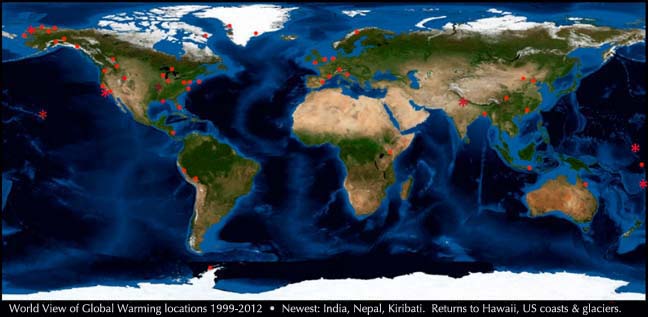
This project would be impossible without scientists and observers around the world who have provided hundreds of scientific contacts and papers. See Background, Advisors, and Reference for documentation, funders and major advisors, without whom I could not complete the work.
World View of Global Warming is a project of the Blue Earth Alliance, Seattle Washington, a 501(c)3 tax-exempt organization. The project is supported entirely by donations, grants, and license fees for the photographs. Please see information about how to contribute.
For other information about Gary Braasch's climate change projects and books, please see the books Earth Under Fire and How We Know What We Know About Our Changing Climate, and the exhibit "Climate Change in Our World" at the Books and Exhibits link.
COPYRIGHT NOTICE:
Photography and text Copyright © 2005 - 2017 (and before) Gary Braasch All rights reserved. Use of photographs in any manner without permission is prohibited by US copyright law. Photography is available for license to publications and other uses. Please contact requestinformation@worldviewofglobalwarming.org. View more of Gary Braasch's photography here.



